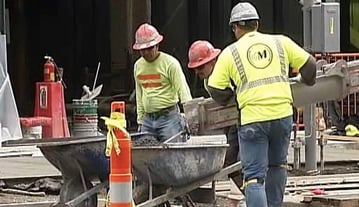 Highs and Lows in the Construction Industry
Highs and Lows in the Construction Industry
While investigators try to determine the causes of this week's deadly Amtrak crash in Philadelphia, others are looking at a larger, systemic issue - Government spending on construction has fallen to its lowest level in at least 22 years. This week's Super Six focuses on this alarming trend, as well as some more positive news on technological advances in the construction industry.
-
An insightful story in The New York Times points out that while investigators are focusing on excess speed as a cause of the terrible Amtrak crash, there is a related issue: the overall condition of Amtrak and the nation’s infrastructure. One of the reasons that American trains should not travel 100 miles an hour in many places is that the state of our rail system — like the state of our bridges, highways and airports — is not good.

-
Is the deadly crash a wake-up call for our legislators on Capitol Hill? Roads & Bridges magazine reports that the outlook does not look good. The Senate is planning to hold a hearing for a six-year transportation funding bill, but not until after the pending May 31 deadline for extending the current infrastructure spending measure. House Republicans voted to cut Amtrak’s budget by approximately a fifth. Republicans also rejected funding for an advanced speed-control technology that federal investigators said would have prevented the crash. In an earlier Hub story, we urge everyone to contact your U.S. senators and congressional representatives to support adequate funding of the transportation bill. Our economy and safety depends on it!
-
Another threat to the U.S. construction industry is a lack of skilled workers, which is difficult to fathom with so many people still looking for work after the Great Recession. Kirotv.com reports on an effort in the Seattle area to get younger workers to join the construction industry. A local construction executive notes that key projects may be held up by an eminent shortage of construction workers within the next four to six months that will last several years.

-
On a more positive note, there were several technologies reported on this week that promise to make the construction industry more efficient and our transportation system safer. Equipment World magazine reports that vehicle-to-vehicle communication technology has the potential to revolutionize road safety and driving in general, and it could become the norm in just a few years.
- The use of wood as a commercial construction material is making a comeback thanks new technologies like Cross-Laminated Timber (CLT) that are letting architects and engineers do bigger and taller buildings, using massive wood elements built up from plantation wood "grown like Christmas trees," according to treehugger.com.
- Our last story in this week's Super Six is not a new technology but is innovative nonetheless in our opinion; Caterpillar unveiled a new fuel guarantee initiative that will give participating contractors $1 back for every gallon of diesel their newly acquired machines burn above the benchmarked rates established by the company, according to Equipment World magazine. We applaud any company that focuses on the fuel economy issue; our R&D folks put tremendous efforts into designing tires that operate effectively on and off the road for optimum fuel efficiency.





